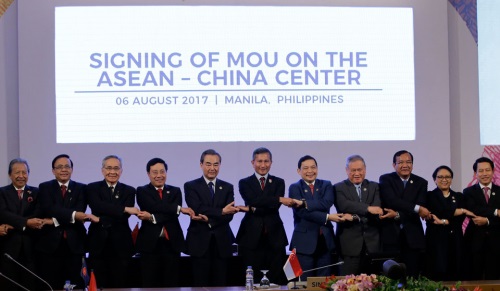On 6 August 2017 in Manila (The Philippines), the foreign ministers of China and ASEAN endorsed the framework on the Code of Conduct for the East Sea (COC). This document represents an important advance in the management of conflicts in the East Sea between ASEAN and China. The framework consists of three parts: Preambular Provision, General Provision, and Final Clauses.
 |
| ASEAN Foreign Ministers and Chinese counterpart at the conference |
“Preambular Provisions” composes of three items: Bases of the COC; Interconnection and interaction between DOC and COC; and Importance and aspirations.
“General Provisions” consists of three parts: Objectives, Principles, and Basic undertakings.
- Objectives: (1). To establish a rules-based framework containing a set of norms to guide the conduct of parties and promote maritime cooperation in the South China Sea; (2). To promote mutual trust, cooperation and confidence, prevent incidents, manage incidents should they occur, and create a favourable environment for the peaceful settlement of the disputes. (3). To ensure maritime security and safety and freedom of navigation and overflight.
- The “Principles” section is divided into four parts. First, the COC is “Not an instrument to settle territorial disputes or maritime delimitation issues.” Second, commit to the purposes and principles of the United Nations Charter, the 1982 United Nations Convention on the Law of the Sea (UNCLOS), the Treaty of Amity and Cooperation, the Five Principles of Peaceful Coexistence and “other universally recognized principles of international law”. Third, commit to full and effective implementation of the DOC. Fourth, Respect for each other’s independence, sovereignty and territorial integrity in accordance with international law, and the principle of non-interference in the internal affairs of other states.
- “Basic undertakings” consists of six parts: Duty to cooperate; Promotion of practical maritime cooperation; Self-restraint/Promotion of trust and confidence; Prevention of incidents; Management of incidents; Other undertakings in accordance with international law, to fulfill the objectives and principles of the COC.
According to analysts, though inadequacies remain, the framework serves as an important basis for the management and settlement of disputes and conflicts in the East Sea between ASEAN and China in order to reach an effective and a legal-binding COC, contributing to maintaining peace and stability in the region. This is the common wish among ASEAN member states. Through this important event, international opinion has voiced their support for a more legally-binding COC and more importantly, the COC will soon be reached and put into effect in reality.
Nguyen Van Su